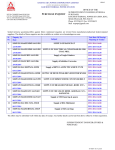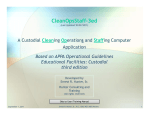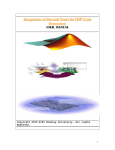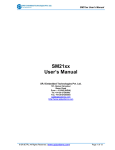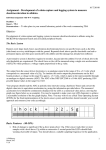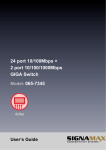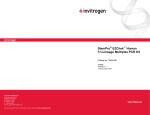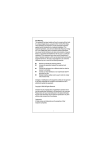Download Capstone Design Document
Transcript
Capstone Design Document Project Sponsor: Dr. Joseph Morgan, D.E., P.E., PMP Project Advisor: Dr. Jay Porter Alpha Engineering Systems March 2, 2007 Problem Statement If you have ever created a network in your home or office building then you understand the frustration of running cables through the building, or having to run the cables through the walls. What if this problem could be as simple as plugging into an outlet? How simple would it be to have a device that could utilize the standard outlets in all buildings, create a network, and be able to accept an interchangeable card? The application card could give the user the ability to regulate their use of electricity, communicate between computers, configure a home theater, and much more just by plugging into an outlet. Alpha Engineering Systems (AES) is proposing just that with WireNet and an application card HECS (Home Entertainment Configuration System). The project will last approximately four and a half months. WireNet is a broadband over power lines (BPL) device that would create a network with a computer that is connected to a separate BPL unit, and an application card HECS) that uses infrared (IR) transmission to communicate with audio/video (A/V) equipment, using WireNet to create a network for the A/V equipment. Functional Requirements Wire Net Base Station Requirements Operates on 120VAC at 60Hz Regulated DC Power High Performance Microcontroller 1 Mbyte of flash memory BPL communication HECS Application Card Requirements IR transmit range of 20 ft. minimum 128Kbytes of flash memory WireNet 1 March 2, 2007 Conceptual Design The conceptual block diagram is shown in Figure 1. As seen from Figure 1, WireNet communicates using BPL to a computer, where the user designates the A/V equipment that they own through a GUI interface. Once all devices are selected, the GUI interface sends the data to WireNet, which transmits the configuration data to the application card to be transmitted to the A/V devices using infrared transmission. Figure 1. Conceptual Block Diagram. WireNet 2 March 2, 2007 Performance Requirements Wire Net Base Station Requirements Operates on 120VAC at 60Hz Regulated DC Power +5VDC @ 1A -5VDC @ 250mA +12VDC @ 1A +3.3VDC @ 500mA High Performance Microcontroller 32-bit Microcontroller 512Kbytes of flash memory Fast Ethernet controller UART I2C 8 10-bit ADCs Programmable Interrupt Timer (PIT) 7 External interrupt lines Ability to address external memory with a bus interface 32 General Purpose Input Output Pins 1 Mbyte of flash memory BPL communication HECS Application Card Requirements IR transmit range of 20 ft. minimum 128Kbytes of flash memory WireNet 3 March 2, 2007 Technology Survey Assessment Wire Net Base Station Requirements • Requires 120VAC at 60Hz o Pros Never need to replace or charge batteries Can use the same wire for power and BPL Can supply plenty of current to an application card if needed o Cons Makes the device vulnerable to power surges Power supply will be larger and more expensive than if using battery power • Device will be inoperable during a power failure Regulated DC Power o Pros Provides power for logic chips Powers small motors or relays that are located on or attached to an application card. No external plug-in transformers are needed to supply extra power to an application card • High Performance Microcontroller o Pros A microcontroller with a large number of on chip features will reduce the parts count. A high end microcontroller will provide plenty of computing power for future uses. A high end microcontroller will be easier to program in a high level language. o Cons WireNet 4 March 2, 2007 High end microcontrollers are more expensive. High end microcontrollers consume more power and produce more heat. Many pins serve two or three functions so some hardware complexity will be introduced. • A high end microcontroller uses more power. 1 Mbyte of flash memory o Pros Provides plenty of room for more complex future programs 1 Mbyte of memory is relatively inexpensive Enables devices to log data for longer periods of time o Cons • More expensive than using only the memory in the microcontroller Adds circuit design and PCB layout complexity Adds complexity to the microcontroller programming BPL communication o Pros BPL communications are more reliable than wireless connections and less prone to interference. BPL has a much greater range than Wi-Fi connections and is only blocked by line transformers allowing a signal range that covers an entire building no matter the size. Faster than 802.11a/b/g HECS Application Card Requirements • IR Transmission range of 20 ft. minimum o Pros Able to transmit to wide range of devices 20 ft. range larger than most rooms Infrared is a universal control format o Cons WireNet 5 March 2, 2007 • Possibility of not reaching all devices Only line of sight 128Kbytes of flash memory o Pros Provides plenty of room for more 128Kbytes of memory is relatively inexpensive Enables devices to log data for longer periods of time o Cons More expensive than using only the memory in the microcontroller Adds circuit design and PCB layout complexity Adds complexity to the application card Detailed Functional Block Diagram The WireNet module will be the most complex piece of hardware to design. The detailed block diagram for WireNet is shown in Figure 2. The WireNet module will have a power supply to provide power for internal components as well as provide power to an application card. The BPL chipset will interface with the power wiring of the building and send and receive Ethernet frames using the building wiring. The BPL chipset will communicate with the microcontroller using the 802.3 standard. The microcontroller will communicate directly with the application card using digital and analog lines. WireNet 6 March 2, 2007 Figure 2. WireNet Functional Block Diagram. The functional block diagram for HECS is shown in Figure 3. The data from WireNet will be transmitted through the 96 pin card interface connector to the infrared driver before being sent through the infrared transmitter. The purpose of the HECS application card will be to automate the control of home entertainment equipment. WireNet 7 March 2, 2007 Figure 3. HECS Functional Block Diagram. Milestones Milestones are events that allow the customer to measure AES's progress toward the completion of WireNet and HECS. The Milestones timeline is shown in Figure 5. 9/10/07 Completion of Research 10/8/07 Completion/Acceptance of BPL Circuit 9/24/07 Completion/Acceptance of Microcontroller Circuit • 11/5/07 Completion/Acceptance of Testing Software 10/22/07 Completion/Acceptance of Interface Software 12/3/07 Completion/Acceptance of Documentation 11/19/07 Completion/Acceptance of Prototype Completion of Research – Research will encompass specifications of the Infrared transmission, microcontroller capabilities, BPL (chipset and how to transmit/receive). • Completion/Acceptance of Microcontroller Circuit – The microcontroller circuit will detail how the microcontroller connects with HECS and the components on the PCB. • Completion/Acceptance of BPL Circuit – The BPL circuit will be the connection of the BPL chipset and microcontroller that will accept an application card. WireNet 8 March 2, 2007 • Completion/Acceptance of Interface Software – The interface software will be needed for WireNet and HECS to communicate with the A/V equipment. • Completion/Acceptance of Testing Software – The testing software will display information transmitted via BPL from WireNet on a computer. • Completion/Acceptance of Prototype – A prototype will be built to demonstrate the functionality of WireNet and HECS. The customer must be satisfied that this demonstration encompasses the scope of the project. • Completion/Acceptance of Documentation – Documentation of the project will include an installation guide, schematics, specifications, software guide, test plans, test results and a user manual. These documents will allow the customer to install and use WireNet and the application card HECS successfully. DELIVERABLES Deliverables include documentation, technical troubleshooting guide, and other items of value that will be provided to the customer. The deliverables timeline is shown in Figure 6. 9/17/07 10/4/07 Preliminary Schematics Software Flowchart 9/27/2007 Preliminary PCB Layout 10/22/07 Test Plan 10/15/07 Software Code 11/5/07 Final Schematic 10/29/07 Test Results 11/22/07 Prototype 12/3/07 User Manual 11/14/07 11/28/07 12/11/07 Final PCB Layout Installation Guide Bill of Materials Figure 4. Deliverables Timeline. • Preliminary Schematics – The preliminary schematics will be an initial visual representation of the parts used to create WireNet and HECS to illustrate the connections between these parts. • Preliminary PCB Layout – The initial layout of the components on the printed circuit board is necessary in order to have the PCB reproduced and populated. The PCB board will be created using OrCAD Layout. WireNet 9 March 2, 2007 • Software Flowchart – The software flowchart will explain the flow and operation of the software in WireNet and HECS's microcontroller, the user interface, as well as how it is used to transmit data to the A/V equipment. • Software Code – The software code for WireNet's microcontroller and interface will be provided, as well as HECS user interface. • Test Plan – The test plan will consist of the steps taken to verify the successful operation of the WireNet and HECS prototype. • Test Results – The test results will demonstrate how WireNet and HECS operate. • Final Schematic – The final schematic will be the final visual representation of the parts used to create WireNet and HECS to illustrate the connections between these parts. • Final PCB Layout – The final layout of the components on the printed circuit board is necessary in order to have the PCB reproduced and populated. The PCB board will be created using OrCAD Layout. • Prototype – The prototype will be a working model of WireNet, with the HECS application card connected to multiple A/V equipment to demonstrate functionality. • Installation Guide – The installation guide will detail steps for the installation of WireNet and HECS with audio/video equipment. • User Manual – The user manual will illustrate the operation of WireNet and HECS. • Bill of Materials – The bill of materials will list each component, with price, used in the construction of WireNet and HECS. WireNet 10 March 2, 2007











